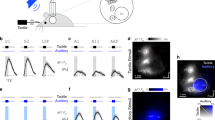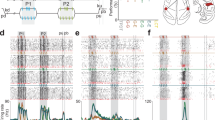Abstract
We used simultaneous multi-site neural ensemble recordings to investigate the representation of tactile information in three areas of the primate somatosensory cortex (areas 3b, SII and 2). Small neural ensembles (30–40 neurons) of broadly tuned somatosensory neurons were able to identify correctly the location of a single tactile stimulus on a single trial, almost simultaneously. Furthermore, each of these cortical areas could use different combinations of encoding strategies, such as mean firing rate (areas 3b and 2) or temporal patterns of ensemble firing (area SII), to represent the location of a tactile stimulus. Based on these results, we propose that ensembles of broadly tuned neurons, located in three distinct areas of the primate somatosensory cortex, obtain information about the location of a tactile stimulus almost concurrently.
This is a preview of subscription content, access via your institution
Access options
Subscribe to this journal
Receive 12 print issues and online access
$209.00 per year
only $17.42 per issue
Buy this article
- Purchase on Springer Link
- Instant access to full article PDF
Prices may be subject to local taxes which are calculated during checkout









Similar content being viewed by others
References
Kaas, J. H. & Pons, T. P. in Comparative Primate Biology 4, 421–468 (ed. Steklis, H.D. & Erwin,. J) (Alan R. Liss, New York, 1988).
Hopfield, J. J. Pattern recognition computation using action potential timing for stimulus representation. Nature 376, 33– 36 (1995).
Hopfield, J. J. & Herz, A. V. Rapid local synchronization of action potentials: toward computation with coupled integrate-and-fire neurons . Proc. Natl. Acad. Sci., USA 92, 6655– 6662 (1995).
Grossberg, S. How does a brain build a cognitive code? Psychol. Rev. 87, 1–51 (1980).
Middlebrooks, J. C., Clock, A. E., Xu, L. & Green, D. M. A panoramic code for sound location by cortical neurons. Science 264 , 842–844 (1994).
Hebb, D. O. The Organisation of Behavior (Wiley, New York, 1949 ).
Erickson, R. P. Stimulus encoding in topographic and non-topographic afferent modalities: on the significance of the activity of individual sensory neurons. Psychol. Rev. 75, 447–465 (1968).
Wise, S. P. & Desimone, R. Behavioral neurophysiology: insights into seeing and grasping. Science 242, 736 –741 (1988).
Bullier, J. & Nowak, L. G. Parallel versus serial processing: new vistas on the distributed organization of the visual system. Curr. Opin. Neurobiol. 5, 497–503 (1995).
Schiller, P. H. On the specificity of neurons and visual areas. Behav. Brain Res. 76, 21–35 ( 1996).
Georgopoulos, A. P., Schwartz, A. B. & Kettner, R. E. Neuronal population encoding of movement direction . Science 233, 1416–1419 (1986).
Churchland, P. S. & Sejnowski, T. J. The Computational Brain (MIT Press, Cambridge, Massachusetts, 1992).
Nicolelis, M. A. L., Ghazanfar, A. A., Faggin, B. M., Votaw, S. & Oliveira, L. M. O. Reconstructing the engram: simultaneous, multisite, many single neuron recordings. Neuron 18, 529–537 ( 1997).
Nicolelis, M. A. L., Stambaugh, C. R., Brisben, A. & Laubach, M. in Methods in Neural Ensemble Recordings (ed. Nicolelis, M. A. L.) (CRC, New York, in press).
Kaas, J. H. in Aotus: the Owl Monkey (eds Baer, J. F., Weller, R. E. & Kakoma, I.) 322–347 (Academic, San Diego, 1994).
Chapman, C. E. & Ageranioti-Belanger, S. A. Discharge properties of neurones in the hand area of primary somatosensory cortex in monkeys in relation to the performance of an active tactile discrimination task. I. areas 3b and 1. Exp. Brain Res. 87, 319–339 (1991).
Iwamura, Y., Tanaka, M. & Hikosaka, O. Overlapping representations of fingers in the somatosensory cortex (area 2) of the conscious monkey. Brain Res. 197, 516–520 (1980).
Nicolelis, M. A. L. & Chapin, J. K. Spatiotemporal structure of somatosensory responses of many-neuron ensembles in the rat ventral posterior medial nucleus of the thalamus. J. Neurosci. 14, 3511–3532 (1994).
Nicolelis, M. A. L., Baccala, L. A., Lin, R. C. & Chapin, J. K. Sensorimotor encoding by synchronous neural ensemble activity at multiple levels of the somatosensory system. Science 268, 1353–1358 (1995).
Bell, A. J. & Sejnowski, T. J. An information maximization approach to blind separation and blind deconvolution. Neural Comput. 7, 1129–1159 ( 1995).
Vaadia, E. et al. Dynamics of neuronal interactions in monkey cortex in relation to behavioral events. Nature 373, 515– 518 (1995).
Seidemann, E., Meilijson, I., Abeles, M., Bergman, H. & Vaadia, E. Simultaneously recorded single units in the frontal cortex go through sequences of discrete and stable states in monkeys performing a delayed localization task. J. Neurosci. 16, 752–768 (1996).
Singer, W. & Gray, C. M. Visual feature integration and the temporal correlation hypothesis. Annu. Rev. Neurosci. 18, 555–586 (1995).
Shadlen, M. N. & Newsome, W. T. Noise, neural codes and cortical organization. Curr. Opin. Neurobiol. 4, 569–579 (1994).
Ferrington, D. G. & Rowe, M. Differential contributions to the coding of cutaneous vibratory information by cortical somatosensory areas I and II. J. Neurophysiol. 43, 310 –331 (1980).
Merzenich, M. M. & Kaas, J. H. Principles of organization of sensory-perceptual systems in mammals. Prog. Psychobiol. Physiol. Psych. 9, 1–41 (1980).
Kaas, J. H. & Garraghty, P. E. Hierarchical, parallel, serial arrangements of sensory cortical areas: connection patterns and functional aspects. Curr. Opin. Neurobiol. 1, 248– 251 (1991).
Van Essen, D. C., Anderson, C. H. & Felleman, D. J. Information processing in the primate visual system: an integrated systems perspective. Science 255, 419–423 (1992).
Nicolelis, M. A. L., Fanselow, E. E. & Ghazanfar, A. A. Hebb's dream: the resurgence of cell assemblies. Neuron 19, 219–221 ( 1997).
McClurkin, J. W. & Optican, L. M. Primate striate and prestriate cortical neurons during discrimination. I. simultaneous temporal encoding of information about color and pattern. J. Neurophysiol. 75, 481–495 ( 1996).
Victor, J. D. & Purpura, K. P. Nature and precision of temporal coding in visual cortex: a metric-space analysis. J. Neurophysiol. 76, 1310–1326 ( 1996).
Abeles, M. & Goldstein, M. Multiple spike train analysis . IEEE Proc. 65, 762–773 (1977).
Nicolelis, M. A. L., Lin, R. C. S. & Chapin, J. K. Neonatal whisker removal reduces the discrimination of tactile stimuli by thalamic ensembles in adult rats. J. Neurophysiol. 78, 1691–1706 ( 1997).
Bishop, C. M. Neural Networks for Pattern Recognition (Oxford Univ. Press, New York, 1995).
Zipser, D. & Andersen, R. A. A back-propagation programmed network that simulates response properties of a subset of posterior parietal neurons. Nature 331, 679– 684 (1988).
Johnson, K. O., Hsiao, S. S. & Twombly, I. A. in The Cognitive Neurosciences (ed. Gazzaniga, M. S.) 253–267 (MIT Press, Cambridge, Massachusetts, 1997).
Kohonen, T. Self-Organizing Maps (Springer, New York, 1997).
Sarle, W. S. Stopped training and other remedies for overfitting. Proc. 27th Symp. Interface Comp. Sci. Stat. 1, 352– 360 (1995).
Acknowledgements
We thank Bret Carswell, Scott Votaw and Marshall Shuler for technical assistance, and Harvey Wiggins (Plexon), Alex Kirilov (Plexon) and Larry Andrews (NBLABS) for hardware and software support. This work was supported by the McDonnell Pew Foundation, the Duke-Sandoz program, a contract from the NINDS Neuroprosthetic program to J.K.C. and M.A.L.N. and a Whitehead Scholar award to M.A.L.N.
Author information
Authors and Affiliations
Corresponding author
Rights and permissions
About this article
Cite this article
Nicolelis, M., Ghazanfar, A., Stambaugh, C. et al. Simultaneous encoding of tactile information by three primate cortical areas. Nat Neurosci 1, 621–630 (1998). https://doi.org/10.1038/2855
Received:
Accepted:
Issue Date:
DOI: https://doi.org/10.1038/2855
This article is cited by
-
A cortico-collicular circuit for orienting to shelter during escape
Nature (2023)
-
Bayesian prediction of psychophysical detection responses from spike activity in the rat sensorimotor cortex
Journal of Computational Neuroscience (2023)
-
Principles of neural ensemble physiology underlying the operation of brain–machine interfaces
Nature Reviews Neuroscience (2009)



